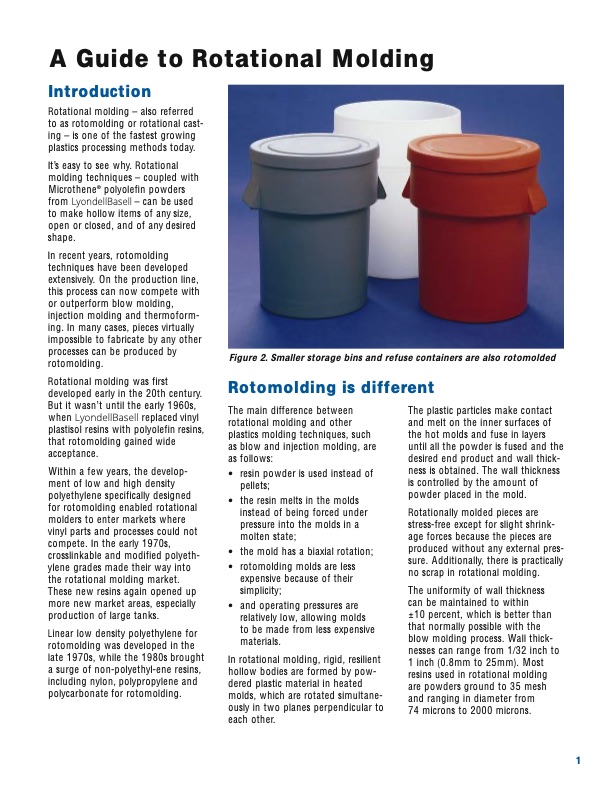
PDF Publication Title:
Text from PDF Page: 003
A Guide to Rotational Molding Introduction Rotational molding – also referred to as rotomolding or rotational cast- ing – is one of the fastest growing plastics processing methods today. It’s easy to see why. Rotational molding techniques – coupled with Microthene® polyolefin powders from LyondellBasell – can be used to make hollow items of any size, open or closed, and of any desired shape. In recent years, rotomolding techniques have been developed extensively. On the production line, this process can now compete with or outperform blow molding, injection molding and thermoform- ing. In many cases, pieces virtually impossible to fabricate by any other processes can be produced by rotomolding. Rotational molding was first developed early in the 20th century. But it wasn’t until the early 1960s, when LyondellBasell replaced vinyl plastisol resins with polyolefin resins, that rotomolding gained wide acceptance. Within a few years, the develop- ment of low and high density polyethylene specifically designed for rotomolding enabled rotational molders to enter markets where vinyl parts and processes could not compete. In the early 1970s, crosslinkable and modified polyeth- ylene grades made their way into the rotational molding market. These new resins again opened up more new market areas, especially production of large tanks. Linear low density polyethylene for rotomolding was developed in the late 1970s, while the 1980s brought a surge of non-polyethyl-ene resins, including nylon, polypropylene and polycarbonate for rotomolding. Figure 2. Smaller storage bins and refuse containers are also rotomolded Rotomolding is different The main difference between rotational molding and other plastics molding techniques, such as blow and injection molding, are as follows: • resin powder is used instead of pellets; • the resin melts in the molds instead of being forced under pressure into the molds in a molten state; • the mold has a biaxial rotation; • rotomolding molds are less expensive because of their simplicity; • and operating pressures are relatively low, allowing molds to be made from less expensive materials. In rotational molding, rigid, resilient hollow bodies are formed by pow- dered plastic material in heated molds, which are rotated simultane- ously in two planes perpendicular to each other. The plastic particles make contact and melt on the inner surfaces of the hot molds and fuse in layers until all the powder is fused and the desired end product and wall thick- ness is obtained. The wall thickness is controlled by the amount of powder placed in the mold. Rotationally molded pieces are stress-free except for slight shrink- age forces because the pieces are produced without any external pres- sure. Additionally, there is practically no scrap in rotational molding. The uniformity of wall thickness can be maintained to within ±10 percent, which is better than that normally possible with the blow molding process. Wall thick- nesses can range from 1/32 inch to 1 inch (0.8mm to 25mm). Most resins used in rotational molding are powders ground to 35 mesh and ranging in diameter from 74 microns to 2000 microns. 1PDF Image | A Guide to Rotational Molding Lyondellbasell

PDF Search Title:
A Guide to Rotational Molding LyondellbasellOriginal File Name Searched:
a-guide-to-rotational-molding-5717.pdfDIY PDF Search: Google It | Yahoo | Bing
Development of a solar powered Electric Ship The Electricship website originally started off as a project to develop a comprehensive renewable, affordable, modular electric ship... More Info
Modular Boat Hull Composite The case for a unsinkable, modular composite hybrid boat hull... More Info
MS Burgenstock Hybrid Electric Catamaran Lake Lucerne Unique shuttle servicing Lucerne to the Burgenstock Resort... More Info
Ground Power Unit GPU Powered by Lithium Ion Batteries The goal of the Ground Power Unit is to provide a readily accessible, modular, ready-to-power solution for remote power... More Info
| CONTACT TEL: 608-238-6001 Email: greg@electricship.com | RSS | AMP |